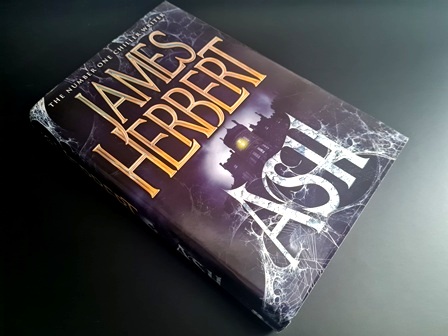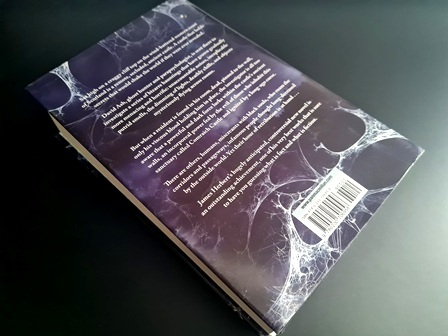
DLS Synopsis:
The Psychical Research Institute had fallen upon hard times of late. Kate McCarrick, head of the institute, was all too aware of this fact. And so, when their small firm was approached by Simon Maseby in relation to a possible haunting that had been disturbing the residents at an exclusive VIP hideaway on the western coast of Scotland, McCarrick didn’t need to give the offer much thought. With the fees being offered easily enough to see the institute through their current financial worries, McCarrick knew that the job could only be trusted in the hands of one particular employee – David Ash.
After agreeing to take on the incredibly lucrative assignment and subsequently signing two contracts swearing the psychic investigator to an unbelievable level of secrecy, thirty-eight-year-old David Ash is flown up to the secluded castle where his investigations will be undertaken – a grand fourteenth century castle, built on the edge of the cliff top, known as Comraich Castle.
However, as the private jet is approaching Prestwick, the engines fail, leaving the plane nothing more than a deadweight plummeting downwards, until finally the engines kick in again and the few passengers and crew members aboard are able to land; shaken up but otherwise fine.
From there Ash is driven to Comraich Castle, whereby he is met by Sir Victor Haelstorm – the brutish CEO of Comraich Castle. Introductions are swift and Ash is soon shown to his room by the general manager of the estate – Andrew Derriman. After settling in, Ash begins some initial information gathering; questioning Derriman and the Senior Security Officer, Kevin Babbage, on the incident which led the owners of Comraich Castle to seeking out the Psychical Research Institute’s services.
Along with a number of other unexplainable and disturbing phenomena that has taken place in the grand castle in recent weeks, Ash is told in shocking detail of the horrific death of the millionaire venture capitalist - Douglas Hoyle. Having been hoisted up against the medical unit wall in a grotesque parody of the crucifixion pose, all without the use of any nails or visible physical apparatus, the once publically shamed resident was pronounced deceased shortly after.
Already picking up strong vibrations of spiritual unrest within the vast stone walls of Comraich, Ash begins to feel increasing concerned at investigating such a dangerous level of activity on his own. However, such an independent assessment was a specific stipulation of the contract, which both he and McCarrick had accepted.
Equally as worrying is the politically and morally unsound sanctum that is being offered to such high profile VIP’s who have needed to flee from the public eye under the false pretence of their own death. Under the protection of a wealthy and powerful cabal known as the ‘Inner Court’, these disgraced and publically despised individuals are given a safe refuge for the rest of their lives; living in absolute luxury in exchange for vast sums of money. And in amongst these high profile criminals, infamous tyrants and political pariahs, Ash is required to undergo an investigation on the sudden influx of unexplainable phenomena.
But there is something evil and powerful growing in the depths of the highly secret sanctuary. A dark force that is being channelled through the corridors and passageways, creating untold havoc for the distasteful inhabitants of Comraich. An evil power that takes an instant reaction to the presence of Ash. And one that, over the course of Ash’s investigations, will rip apart the once peaceful sanctuary, spreading fear, death and despair amongst the many guests.
For so many black souls housed under one roof, the tides are turning, and they must each finally face their own personal demons…
DLS Review:
So, here we have it, Herbert’s much-loved anti-hero, David Ash, is back and he’s getting served up another dose of a good old fashioned haunting. And the first thing that’s on everyone’s mind is, how will this final part to the ‘David Ash Trilogy’ compare to ‘Haunted’ (1988) and ‘The Ghosts Of Sleath’ (1994)? Here’s how…
The novel begins with a controversially-risky Princess Diana scene, which sets in motion the ‘real-life-characters-interwoven-into-a-fictional-plot’ literary angle that Herbert utilises throughout the length of the novel. With the short Diana scene out of the way, Herbert commences with the introduction of Cedric Twigg, a sixty-one-year-old assassin suffering from the first signs of severe arthritis. Twigg’s role in the tale is a very background (yet ultimately vital) one, with the shifty loner adding another whole layer to the Inner Court dynamic that is sadly never really developed to a particularly insightful extent.
From here it’s a reasonably reserved laying down of the basic plot, only very gradually building up enough momentum to get the novel into a respectfully steady pace. Indeed, it’s over one-hundred pages before Ash has even set foot in Comraich Castle. The trip up there, alongside Kate McCarrick’s own enquiries into the Castle and the Inner Court, taking up the majority of the pages until the psychic investigator’s eventual arrival.
Along the way we are introduced to Dr Delphine Wyatt – Comraich’s own in-house psychologist who’s (predictably) young, pretty and an instant love-interest for Ash. However, aside from some early character establishing, Herbert barely develops upon this key-character for the rest of the novel. And within the space of just a few hours the two are a couple, slipping under the bedsheets for a dose of quite tastefully restrained rumpy-pumpy.
With the luxurious castle setting firmly established, Herbert starts injecting in a whole host of (pretty darn controversial) real-life-characters. Dr David Kelly (whose death we are told was not actually a suicide, but rather the work of ‘IC’ assassin Eddy Nelson), Lord Lucan, Aribert Heim, Alois Brunner along with a whole load of other such infamous and universally-hated deviants.
Surprisingly, it’s a good while until Herbert starts to really crank up the full-on-haunting of the castle. There are suggestive snippets here and there, but it’s still not until a good portion of the novel is under the reader’s belt before we have our first full-blown horror episode. But when he delivers…Herbert really delivers.
Although there’s quite substantial troths between each peak of horror-ladened-action, Herbert still manages to maintain a pretty-darn compelling pace; keeping every aspect of the tale tightly linked, and the growing intrigue surrounding the Inner Court constantly churning away. And it’s this other ‘conspiracy-thriller’ side of the novel that really takes up a hefty chunk of the plot. The Inner Court and all their controversial shenanigans really do take a major plot defining role in the tale. And it’s the paranormal haunting that is slipped around the ‘secret-cabal’ element of the plot – oddly not the other way around.
Ash himself has lost some of his general grittiness. For some reason, Herbert’s made him much more of a stand-up nice guy now. Alcohol and cigarettes have been pretty much abandoned. He’s not as challenging or as self-centred as he was back in the days of ‘Haunted’ (1988) or indeed ‘The Ghosts Of Sleath’ (1994). And partly because of this, the character has lost a huge amount of his overall appeal.
Meanwhile, the plot keeps on, and alongside sporadic mentions of ‘the haunting’ shoehorned in-between the much more prevailing plot of ‘who’s the next infamous resident at Comraich Castle to be uncovered’, Herbert starts to work in his second layer, with the aged assassin Cedric Twigg taking front seat. But the plot slices just don’t rest together that well. And as it all comes together, you can’t help but feel like it’s all just a little too contrived.
But with that all said, somehow it all still works as a story. It keeps you gripped and entertained. Okay, so it’s no ‘Haunted’ (1988) or ‘The Ghosts Of Sleath’ (1994). It’s different…and quite surprisingly so. Since ‘The Ghosts Of Sleath’ (1994), Herbert has changed his writing style a hell of a lot. He’s softened down the horror element. He’s chosen to bring in more characters and put more weight into their interplay. It’s not necessarily a completely bad thing. It’s just a change.
However, for a few brief chapters late on in the tale, the old-style-Herbert gets back in the driving seat and takes the reader through a masterclass in how to deliver a truly spin-tingling-horror sequence involving huge spiders in a deep dark cave. Sounds a little cheesy? Perhaps even a little clichéd? Wait until you read it…Herbert pulls it off with chilling style.
But it has to be said that ‘Ash’ is, in all honesty, little more than a mediocre success. Not a masterpiece of horror – but a subdued success nonetheless. And it’s one I still wouldn’t hesitate to recommend.
The novel runs for a total of 693 pages.

© DLS Reviews
Other ‘David Ash’ instalments:
- ‘Haunted’ (1988)
- ‘The Ghosts Of Sleath’ (1994)
- ‘Ash’ (2012)









